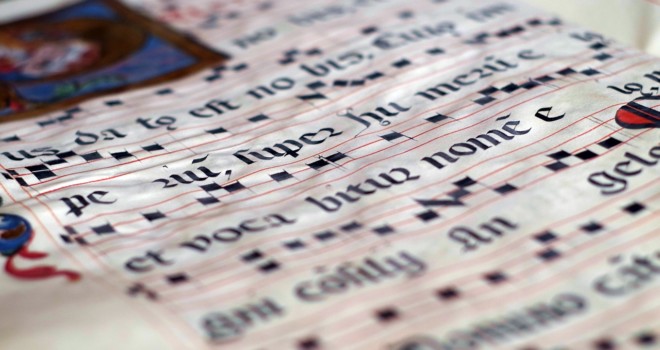When I left the Easter Saturday Mass, the alleluias were ringing in my ears. It had been an exhilarating way to round out the Octave, with lots enthusiastic singing and pervasive joy — alleluia indeed!
Of special note was Fr. Jacob Meyer’s resonant intoning of the Easter Sequence, Victimae paschali laudes (“Christians, Praise the Paschal Victim”) — said in Latin. Since my own Latin is considerably rusty, I scrambled with a hymnal to find an English translation so I could follow along, and I couldn’t help taking note of the Sequence’s author at the bottom of the page: “ascr. to Wipo of Burgundy, d. 1048.”
Yes, that’s right, Wipo. Not exactly a household name (and neither are its variant renderings, “Wippo” and “Wigbert”), and I admit that I did a big double-take the first time I saw it. Nonetheless, you’ll find it in every hymnal’s fine print, although it’s usually hedged a bit with that appended “ascribed to” disclaimer — something that accompanies a lot of ancient attributions. However, the ascription is strong enough that it was repeated three times in the St. Monica hymnal’s index in conjunction with three different settings of the work.
Born around the year 1000, Wipo was ordained a priest, and then he served as a chaplain for the Holy Roman Emperor Conrad II. Wipo also wrote poetry and apothegms, and he authored several works of history and biography that are respected for their stylistic panache and relative objectivity. But, as far as ecclesial matters are concerned, Wipo is just a tentative footnote in our modern hymnals. Neither a pope nor a bishop; not a saint nor a Doctor of the Church; just Wipo — or Wippo, or Wigbert — who may have penned a great Paschal poem that was eventually incorporated into our Sacramentary and Eastertide observances.
In other words, a liturgical one-hit wonder.
And, yet, what a wonder it is. “One of the finest of the transitional Sequences,” according to Sr. J. Isaac Jogues Rousseau, SSND. We all heard Wipo’s masterpiece on Easter Sunday, when it’s obligatory every year, and maybe you’ve been hearing it (or singing it yourself) throughout the week at daily Mass. Like other Sequences, it precedes the proclamation of the day’s Gospel, and it’s an extra, especially jubilant recapitulation of the festival’s core themes – in this case, the Paschal feast’s good news of redemption through Jesus Christ, our resurrected savior.
About halfway through, it declares, “O Mary, come and say what you saw at break of day” – the ideal lead-in to yesterday’s Gospel wherein Mary Magdalene reports to the skeptical Apostles her encounter with the risen Christ. The Eleven likewise balk at a similar testimony from the two Emmaus disciples, and so Jesus finally confronts them in person – no denying the Resurrection at that point! After upbraiding the Apostles for their unbelief, Jesus repeats to them what he’d told Mary: “Go into the whole world and proclaim the Gospel to every creature” (Mk 16.15).
That’s the same commission we heard at the end of the Sequence: “Share the good news, sing joyfully: his death is victory!” Wipo’s Easter poem jubilantly sums up the essence of what we’ve been celebrating throughout the Octave – what we’re living, in fact, as contemporary witnesses to our own transforming encounters with the risen Lord.
And, following Wipo’s lead, those encounters are worth rhapsodizing about, in word and deed. May we do so with flair and delight throughout the sequence of all our days, and may a Wipo-like obscurity attend our efforts that humility be preserved. For even if, with God’s grace, we end up accomplishing great things in temporal terms, it’ll be in our interests if “ascr. to” appends to our names, both now and forever. “Our Christian destiny is, in fact, a great one,” writes Thomas Merton, “but we cannot achieve greatness unless we lose all interest in being great.”
Amen. Al-le-lu-ia.
✠
Image by Henryk Niestrój from Pixabay













